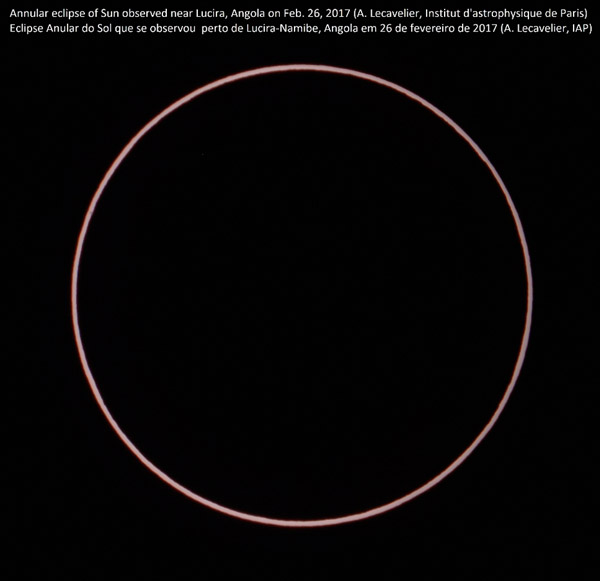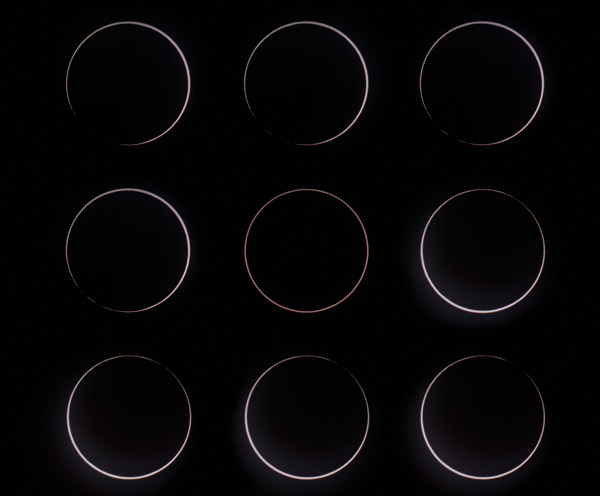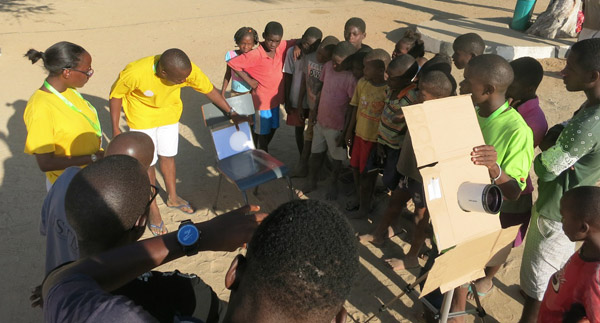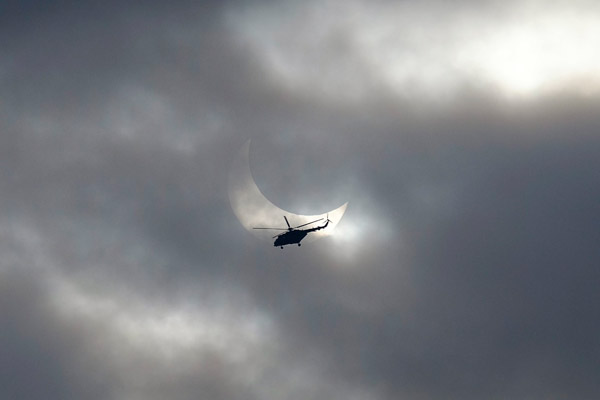OBSERVATION OF THE ANNULAR ECLIPSE OF THE SUN IN ANGOLA ON FEBRUARY 26, 2017
A team of researchers from the Institut d'astrophysique de Paris, Serge Koutchmy, Guillaume Hébrard and Alain Lecavelier des Etangs, took part in an observing campaign of the annular eclipse of the Sun that occurred in Angola on February 26, 2017. The team was part of the expedition organized by the Angolan authorities to a site located on the line of centrality.
An eclipse of the Sun occurs when the Moon passes in front of the Sun and obscures part of the solar disk. The eclipse is called "annular" when the Moon is centered on the solar disk, but is too far from the Earth to cover it entirely. In this case, if the site of observation is located on the "centrality line", i.e. on the extension of the axis that passes through the centers of the Sun and the Moon, one observes a solar ring. The annular phase is brief, with a duration similar to that of a total eclipse (a few minutes or less). On February 26, it lasted 1 minute and 4 seconds at the observing site.
The photographs (Figs. 1 and 2) show that the annular eclipse reveals the shape of the Moon as it is projected as a shadow onto the image of the Sun. The Moon’s shadow has a serrated edge, in contrast to the perfectly circular shape of the solar limb (the Sun is extremely close to a perfect sphere, as its flattening is less than one hundred thousandth its diameter). More than 2800 images were obtained during the eclipse, including more than 300 images during the annular phase. These images are used to constrain the shape of the moon and its flattening (of order of one thousandth its diameter), by comparing it with the circular solar limb. The shape of the Moon is a good probe of how it formed and cooled (see Siegler et al., Nature 2014).
In Angola, the team from the IAP, accompanied by Olivier Urtado (a physical sciences teacher), was hosted by the Instituto Superior Técnico Militar (ISTM), who organized the entire operation. The ISTM is a highly selective Angolan college that trains doctors and engineers. It is directed by Jaime Vilinga, Ph.D. in astrophysics, specializing in the physics of the Sun, who met Serge Koutchmy during his visits to Angola in order to observe the eclipses of 2001 and 2002. Subsequently, Prof. Vilinga conducted his PhD research with Serge Koutchmy at the IAP in 2003-2006. During their journey in Angola, the IAP researchers were able to interact with managers, professors and students from the ISTM.
On the eve of the eclipse, the preparations took place in Lucira, a small village on the Atlantic coast. This village is two days by car south of Luanda, the capital. During the preparations, observations of the Sun were conducted with the students from the ISTM and the inhabitants of the village, in particular, with the children (Fig. 3). In parallel, part of the team reconnoitered the most appropriate site to observe the annular eclipse (on the line of centrality).
On February 26, the day of the eclipse, the sky was partly cloudy. Part of the team stayed in Lucira, accompanied by many inhabitants of the village. The rest of the team went to the observing site with more than 200 persons. While the village of Lucira was cloudy during the entire eclipse, at the site, the observers were fortunate enough to have breaks in the clouds during the actual eclipse.
The observers were visited by the Army Chief of Staff the Angolan Air Force (see Fig. 4 for an original photo). The IAP researchers were also received at the French Embassy in Angola by the Councilor for Cooperation and Cultural Action, with whom they exchanged views on opportunities for scientific cooperation between both countries. The IAP scientists also participated in a day of lectures on eclipses, cosmic rays and extrasolar planets. The lectures were aimed at students and professors of the University of Benguela (the principal town near Lucira).
Acknowledgements
The team from the Institut d'astrophysique de Paris warmly thanks the General Jaime P. Vilinga (ISTM, Luanda) for the welcome given to them in Angola, and Xavier Jubier for its detailed calculations of the eclipse ephemerides.Figures

Figure 1: Picture of the annular eclipse taken exactly at the central time of the eclipse, from the chosen site in Angola located on the line of centrality. The outer edge of the ring corresponding to the solar limb is perfectly circular, whereas the inner edge of the ring corresponds to the Moon shadow and is serrated because of the reliefs on its surface. The flattening of the Moon (one thousandth of its diameter) is not visible by eye, but can be accurately measured from this image.

Figure 2: Montage of the images taken at the central instant of the eclipse (center), and at the times of contact of the lunar edge with the solar limb at the beginning (top and left) and at the end (bottom and right) of the annular phase. The contact phases reveal the lunar relief, with valleys that allow in sunlight, and mountains that reach the solar limb, thus forming dotted lines on the arc of light.
Figure 3: The day before the eclipse, students from ISTM show a sunspot to children from the village of Lucira.
Figure 4: Twenty minutes after the central time of the annular eclipse, an Mi-171Sh helicopter passes in front of the partially eclipsed solar disk.
Writing and contacts
- Alain Lecavelier des Étangs
Institut d’astrophysique de Paris, CNRS, UPMC
lecaveli [at] iap [dot] fr - Guillaume Hébrard
Institut d’astrophysique de Paris, CNRS, UPMC
hebrard [at] iap [dot] fr - Serge Koutchmy
Institut d’astrophysique de Paris, CNRS, UPMC
koutchmy [at] iap [dot] fr
Layout and iconography: Jean Mouette
May 2017


